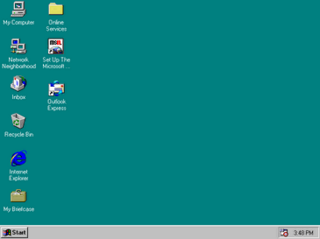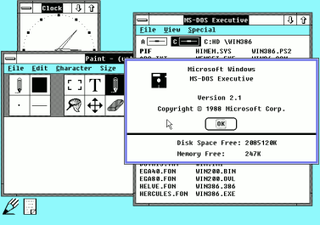This article includes a list of references, related reading or external links, but its sources remain unclear because it lacks inline citations .(March 2010) (Learn how and when to remove this template message) |
32-bit Disk Access (also known as FastDisk) refers to a special disk access and caching mode available in older, MS-DOS-based Microsoft Windows operating systems. It was a set of protected mode device drivers that worked together to take advantage of advanced disk I/O features in the system BIOS. It filtered interrupt 13h BIOS calls to the disk controller and directed them in the most efficient way for the system — either through the 32-bit interface with the hard disk controller or through the system BIOS. Using 32-bit Disk Access allowed for more pageable memory in Windows to page MS-DOS–based applications to disk to free enough RAM for applications when they needed to use it. Sometimes enabling this mode would break older applications of the day.

MS-DOS is an operating system for x86-based personal computers mostly developed by Microsoft. Collectively, MS-DOS, its rebranding as IBM PC DOS, and some operating systems attempting to be compatible with MS-DOS, are sometimes referred to as "DOS". MS-DOS was the main operating system for IBM PC compatible personal computers during the 1980s and the early 1990s, when it was gradually superseded by operating systems offering a graphical user interface (GUI), in various generations of the graphical Microsoft Windows operating system.
Microsoft Windows is a group of several graphical operating system families, all of which are developed, marketed, and sold by Microsoft. Each family caters to a certain sector of the computing industry. Active Windows families include Windows NT and Windows Embedded; these may encompass subfamilies, e.g. Windows Embedded Compact or Windows Server. Defunct Windows families include Windows 9x, Windows Mobile and Windows Phone.
In computing, protected mode, also called protected virtual address mode, is an operational mode of x86-compatible central processing units (CPUs). It allows system software to use features such as virtual memory, paging and safe multi-tasking designed to increase an operating system's control over application software.
Windows 3.1 had an option in its 386 Enhanced Control Panel that would enable 32-bit read & write access in 386 enhanced mode. Usually, 32-bit read could be safely enabled, but 32-bit write had issues with a number of applications. 32-bit Disk Access was the feature that made it possible to page MS-DOS applications to disk. Without it, if the real mode disk code (the Int 13h handler) was paged out, the virtual DOS machine would loop forever.

The Control Panel is a component of Microsoft Windows that provides the ability to view and change system settings. It consists of a set of applets that include adding or removing hardware and software, controlling user accounts, changing accessibility options, and accessing networking settings. Additional applets are provided by third parties, such as audio and video drivers, VPN tools, input devices, and networking tools.
Virtual DOS machines (VDM) refer to a technology that allows running 16-bit/32-bit DOS and 16-bit Windows programs when there is already another operating system running and controlling the hardware.
32-bit disk access should not be confused with 32-bit file access. Although both technologies are similar, 32-bit disk access was introduced with Windows 3.1 and file access with Windows for Workgroups 3.11. 32-bit file access provided a 32-bit code path for Windows to directly access the disk bus by intercepting the MS-DOS Int 21H services while remaining in 386 protected mode and at CPU speeds, rather than handling the Int 21H services in real mode by MS-DOS. 32-bit disk access offers less performance and is less likely to work on many computers than 32-bit file access. 32-bit file access does not require 32-bit disk access.
32-bit file access refers to the higher performance, protected mode disk caching method introduced in Windows for Workgroups 3.11, which replaced SmartDrive (Smartdrv). It bypassed MS-DOS and directly accessed the disk, either via the BIOS or (preferably) 32-bit disk access. This feature was a backport from the then-unreleased Windows 95, as suggested by Microsoft's advertisements for Windows for Workgroups 3.11.
Windows 95, Windows 98, and Windows Me use native, protected mode 32-bit disk drivers during normal operation. However Safe Mode uses MS-DOS real mode disk drivers instead. Real mode MS-DOS drivers could also be used during normal operation for disk peripherals for which Windows did not have native drivers.

Windows 95 is a consumer-oriented operating system developed by Microsoft as part of its Windows 9x family of operating systems. The first operating system in the 9x family, it is the successor to Windows 3.1x, and was released to manufacturing on August 15, 1995, and generally to retail on August 24, 1995. Windows 95 merged Microsoft's formerly separate MS-DOS and Windows products, and featured significant improvements over its predecessor, most notably in the graphical user interface (GUI) and in its simplified "plug-and-play" features. There were also major changes made to the core components of the operating system, such as moving from a mainly co-operatively multitasked 16-bit architecture to a 32-bit preemptive multitasking architecture.

Windows 98 is a graphical operating system developed by Microsoft as part of its Windows 9x family of operating systems. It is the successor to Windows 95, and was released to manufacturing on May 15, 1998, and to retail on June 25, 1998. Like its predecessor, Windows 98 is a hybrid 16-bit and 32-bit monolithic product with the boot stage based on MS-DOS. The startup sound for Windows 98 was composed by Microsoft sound engineer Ken Kato, who considered it to be a "tough act to follow".
32-bit versions of the Windows NT family of operating systems including the newer Windows 2000, Windows XP, Windows Server 2003, Windows Vista and later always have 32-bit disk drivers active, cannot use MS-DOS drivers at all, and the expression is not used for them.
Windows NT is a family of operating systems produced by Microsoft, the first version of which was released on July 27, 1993. It is a processor-independent, multiprocessing and multi-user operating system.

Windows 2000 is an operating system that was produced by Microsoft as part of the Windows NT family of operating systems. It was released to manufacturing on December 15, 1999, and launched to retail on February 17, 2000. It is the successor to Windows NT 4.0.

Windows XP is a personal computer operating system produced by Microsoft as part of the Windows NT family of operating systems. It was released to manufacturing on August 24, 2001, and broadly released for retail sale on October 25, 2001.






